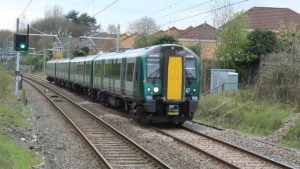This book shows the surprisingly large number of different types of electric locomotives on Britain’s railways and the variety of trains they hauled.
Although main line electrification in the UK dates back over 100 years, it was not until the Manchester to Sheffield line was electrified in 1954 that electric locomotives began to make an impact.
The electrification of suburban systems dates back to before World War I, however, it was when the West Coast Main Line was electrified that electric locomotives began to make a significant contribution to Britain’s railway network.
This book shows the surprisingly large number of different types of electric locomotives that have since evolved and the variety of trains they hauled.
Published in September 2023 by Amberley Publishing and written by George Woods, this soft-cover book has 96 pages, measures around 16.5 cm x 23.4 cm, and contains 180 colour photographs.
It has a published price of £15.99, but at the time of writing, it can be purchased for £14.39 from Amberley Publishing and for £14.53 from Amazon.
The photographs are arranged in groups covering all of the types of electric locomotives that were to be seen on Britain’s railway network since the 1940s, starting with one of the three prototypes introduced by the Southern Railway in 1940, followed by their successors of Classes 71 and 73.
These are followed by Classes 76 and 77 grinding through the Pennines between Manchester and Sheffield, and Classes 86, 87 and 90 on the West Coast Main Line.
A variety of liveries can be seen in Class 91s at work on the East Coast Main Line, and the book concludes with images of Class 92s away from their intended destination of working freights through the Channel Tunnel.
With the necessary infrastructure already in place, the Southern Region was an early advocate of electric locomotives, first with the Class 71 as shown on the right below and the later Class 73s on the left, which also had a diesel engine to allow them to be used on non-electrified routes.
Of the 76 original Class 73s, 12 have been preserved and are in use on heritage lines and 16 are still operational on the national network.

The stifling atmosphere of the line through the Woodhead Tunnel between Sheffield and Manchester must have been a nightmare for train crews, which was relieved by the introduction of the Class 76 locomotives for hauling freight trains and Class 77s for passenger services.
The top-left photograph is typical of a Class 76 on a coal train.
After the closure of the Woodhead Tunnel, the Class 77s were sold to The Netherlands for use on services between The Hague and Maastricht.

Early electric locomotives on the West Coast Main Line were in the hands of Classes 81 to 85 before Classes 86 and 87 became established until the later arrival of Class 90s and ultimately the Pendolinos.
Most of the 86s and 87s received names, being adorned with a red nameplate as seen in the images below.

The Class 90s were derived from the Class 87 for use on passenger and freight services. During their later years of service, they were repainted in a variety of liveries, even including 90029 shown at the top right in the livery of the German National Railway.
Like their Class 86 and 87 predecessors, most of the Class 90s were also named, but not with the same style of cast nameplate with a red background as the 86s and 87s.

This book goes some way to dispelling the myth that after the demise of steam, its replacement by diesel and electric locomotives would herald a never-ending stream of identical-looking metal boxes.
The large number of different classes and even larger number of different liveries shows that there was still plenty of interest to be had in photographing the despised “metal boxes”.
To some extent, the previous fear of monotony is now being realised with the various incarnations of the Hitachi IET trains, but electric locomotives in a host of liveries can still be seen on the East and West Coast Main Lines.
Arranging the book in groups of photos of classes together makes it an easy read, helped by interesting and informative captions, a great variety of subjects, and a good standard of reproduction.
This book is recommended for anyone with a love of the post-steam era or an interest in the development of electric traction and merits a rating of 4.5/5.
The book is available to purchase from Amazon and Amberley Publishing.
We would like to thank Amberley Publishing for providing us with a copy of the book for review.





Responses